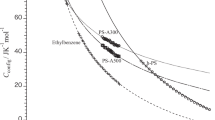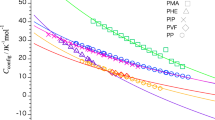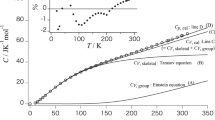Abstract
In this work, we analyze the absolute heat capacity below the glass-transition temperature Tg for two types of amorphous polystyrene with differing low-molecular weights. Both amorphous polystyrenes have excess heat capacities that cannot be reproduced by skeletal and group vibrations from 70 K to Tg, which differs from the results for amorphous polystyrene with large molecular weights. The excess heat capacity is analyzed using the Schottky model. The ratio of the degrees of freedom of the Schottky model NSC for PS-A300 and PS-A500 (NSC,PS-A300/NSC,PS-A500) is 1.6, which reflects the ratio of the end groups per molecule ((i.e., the number of monomer units of PS-A500/the number of monomer units of PS-A300 = 5/3) = 1.7), and the resulting excitation energy (=31 meV) is consistent with that determined using inelastic neutron scattering (=30 meV).
This is a preview of subscription content, access via your institution
Access options
Subscribe to this journal
Receive 12 print issues and online access
$259.00 per year
only $21.58 per issue
Buy this article
- Purchase on Springer Link
- Instant access to full article PDF
Prices may be subject to local taxes which are calculated during checkout




Similar content being viewed by others
References
Wagman DD, Evans WH, Parker VB, Schumm RH, Halow I Bailey SM. The NBS tables of chemical thermodynamic properties: selected values for inorganic and C1 and C2 organic substances in SI units. J Phys Chem Ref Dat. 1982;11:1–392.
Gopal ESR. Specific heats at low temperatures. London: Springer; 2012.
Wunderlich B. Thermal analysis of polymeric materials. Heidelberg: Springer; 2005.
Šesták J, Mareš JJ, Hubík P, editors. Glassy, amorphous and nano-crystalline materials: thermal physics, analysis, structure and properties. Hot topics in thermal analysis and calorimetry. 8, New York: Springer Science & Business Media; 2010.
Gibson GE, Giauque WF. The third law of thermodynamics. Evidence from the specific heats of glycerol that the entropy of a glass exceeds that of a crystal at the absolute zero. J Am Chem Soc. 1923;45:93–104.
Haida O, Matsuo T, Suga H, Seki S. Calorimetric study of the glassy state X. Enthalpy relaxation at the glass-transition temperature of hexagonal ice. J Chem Thermodyn. 1974;6:815–25.
Tajima Y, Matsuo T, Suga H. Calorimetric study of phase transition in hexagonal ice doped with alkali hydroxides. J Phys Chem Solids. 1984;45:1135–44.
Kume Y, Muraoka H, Yamamuro O, Matsuo T. Deuteration-induced phase transition in ammonium hexachloroplumbate. J Chem Phys. 1988;108:4090–7.
Miyazaki Y, Wang Q, Sato A, Saito K, Yamamoto M, Kitagawa H, Mitani T, Sorai S. Heat capacity of the halogen-bridged mixed-valence complex Pt2 (dta)4I (dta = CH3CS2 −). J Phys Chem B. 2002;106:197–202.
Yamamura Y, Nakajima N, Tsuji T, Koyano M, Iwasa Y, Katayama S, Saito K, Sorai S. Low temperature heat capacities and Raman spectra of negative thermal expansion compounds ZrW2O8 and HfW2O8. Phys Rev B. 2002;66:014301.
Matsuo T, Maekawa T, Inaba A, Yamamuro O, Ohama M, Ichikawa M, Tsuchida T. Isotope-dependent crystalline phases at ambient temperature: spectroscopic and calorimetric evidence for a deuteration-induced phase transition at 320 K in α-DCrO2. J Mol Struct. 2006;790:129–34.
Saito K, Sato A, Kikuchi K, Nishikawa H, Ikemoto I, Sorai M. Calorimetric study of metal-insulator transition in (DIMET) 2I3. J Phys Soc Jpn. 2000;69:3602–6.
Yamamuro O, Tsukushi I, Lindqvist A, Takahara S, Ishikawa M, Matsuo T. Calorimetric study of glassy and liquid toluene and ethylbenzene: thermodynamic approach to spatial heterogeneity in glass-forming molecular liquids. J Phys Chem B. 1998;102:1605–9.
Pyda M, Bartkowiak M, Wunderlich B. Computation of heat capacities of solids using a general Tarasov equation. J Therm Anal. 1988;52:631–56.
Wunderlich B. The ATHAS database on heat capacities of polymers. Pure Appl Chem. 1995;67:1019–26.
Yokota M, Sugane K, Tsukushi I, Shibata M. Evaluation of heat capacity below the glass-transition temperature of amorphous polymers composed of carbon backbone. Polym J. (in press).
Westrum Jr. EF, Furukawa GT, McCullough JP. Adiabatic low-temperature calorimetry. In McCullough JP, Scott DW, editors. Experimental thermodynamics, Vol. I, calorimetry of non-reacting systems. London: Butterworths; 1968. p. 133–214.
Wunderlich B, Pyda M. Thermodynamic properties of polymers. Encycl Polym Sci Technol. 2002;12:165–207.
Gaur U, Wunderlich B. Heat capacity and other thermodynamic properties of linear macromolecules. V J Phys Chem Ref Data. 1982;11:313–25.
Tsukushi I, Yamamuro O, Sadanami K, Nishizawa M, Matsuo T, Takeda K. Construction of a top-loading adiabatic calorimeter and enthalpy relaxation of glassy (1,3-propanediol)(0.5)(1,2-propanediamine)(0.5). Rev Sci Instrum. 1998;69:179–84.
Inoue K, Kanaya T, Kiyanagi Y, Shibata K, Kaji K, Ikeda S, Iwasa H, Izumi Y. A crystal analyzer type inelastic spectrometer using the pulsed thermal neutron source. Nucl Instrum Method A 1993;327:433–40.
Fujimura J, Nishiyama E, Tsukushi I, Shibata M. Enthalpy relaxation of low-molecular-weight amorphous styrene oligomers measured with an adiabatic calorimeter. J Therm Anal Calorim. 2019;135:1813–7.
Einstein A. Die Plancksche Theorie der Strahlung und die Theorie der spezifischen Wärme. Ann der Physic. 1907;327:180–90.
Tarasov VV. Heat capacity of anisotropic solids. Zh Fiz Khimii. 1950;24:111–28.
Tarasov VV, Yunitskii GA. Theory of heat capacity of layered-chain and structures. Russ J Phys Chem. 1965;39:1109–11.
Nernst W, Lindemann FA. Spezifische Wärme und Quantentheorie. Z Elektrochem 1911;17:817–27.
Wunderlich B. Motion in polyethylene. II. Vibrations in crystalline polyethylene. J Chem Phys. 1962;37:1207–16.
NIST chemistry WebBook SRD69. 301-975-2000, 100 Bureau Drive Gaithersburg, MD 20899. 1901. https://webbook.nist.gov/cgi/cbook.cgi?ID=C106989&Units=SI&Mask=80#IR-Spec. Accessed 7 Nov 2019.
Krimm S. Infrared spectra of high polymers. Fcrtschr Hochpolym Forsch 1960;Bd.2:S.51–172.
Karasz FE, Bair HE, O’reilly JM. Thermal properties of atactic and isotactic polystyrene. J Phys Chem. 1965;69:2657–67.
Pyda M, Nowak-Pyda E, Mays J, Wunderlich B. Heat capacity of poly (butylene terephthalate). J Polym Sci. 2004;42:4401–11.
Schottky W. The rotation of atomic axes in solids (with magnetic, thermal and chemical applications). Physikalische Z. 1922;23:448–55.
Westrum Jr, Edgar F. Lattice and Schottky contributions to the morphology of lanthanide heat capacities. J Chem Thermodyn. 1983;15:305–25.
Uchida A, Moriya Y, Kawaji H, Atake T, Fukuhara M, Kimura H, Inoue K. Low temperature heat capacity and thermodynamic functions of Zr0.55Al0.10Ni0.05Cu0.30. J Chem Eng Data. 2009;54:2033–37.
Yamashita S, Nakazawa Y, Oguni M, Oshima Y, Nojiri H, Shimizu Y, Miyagawa K, Kanoda K. Thermodynamic properties of a spin-1/2 spin-liquid state in κ-type organic salt. Nat Phys. 2008;4:459–62.
Marshall W, Lovesey SW. Theory of thermal neutron scattering. Oxford: Clarendon; 1971.
Kubota H, Kaneko F, Kawaguchi T. Inelastic neutron scattering study on the polytypism of even-numbered n-alkanes. J Cryst Growth. 2005;275:e2181–86.
Acknowledgements
The authors would like to thank Enago (www.enago.jp) for the English language review.
Author information
Authors and Affiliations
Corresponding author
Ethics declarations
Conflict of interest
The authors declare that they have no conflict of interest.
Additional information
Publisher’s note Springer Nature remains neutral with regard to jurisdictional claims in published maps and institutional affiliations.
Rights and permissions
About this article
Cite this article
Yokota, M., Nishiyama, E., Fujimura, J. et al. Excess heat capacity for low-molecular-weight amorphous polystyrene below the glass-transition temperature: influence of end groups. Polym J 52, 575–580 (2020). https://doi.org/10.1038/s41428-020-0310-4
Received:
Revised:
Accepted:
Published:
Issue Date:
DOI: https://doi.org/10.1038/s41428-020-0310-4
This article is cited by
-
Configurational heat capacity of various polymers above the glass transition temperature
Polymer Journal (2022)
-
Analysis of the configurational heat capacity of polystyrene and its monomer and oligomer above the glass transition temperature
Polymer Journal (2022)
-
Estimation of the configurational heat capacity of polyisobutylene, isobutane and 2,2,4-isomethylpentane above the glass transition temperature
Polymer Journal (2021)
-
Heat capacities of polymer solids composed of polyesters and poly(oxide)s, evaluated below the glass transition temperature
Polymer Journal (2020)



